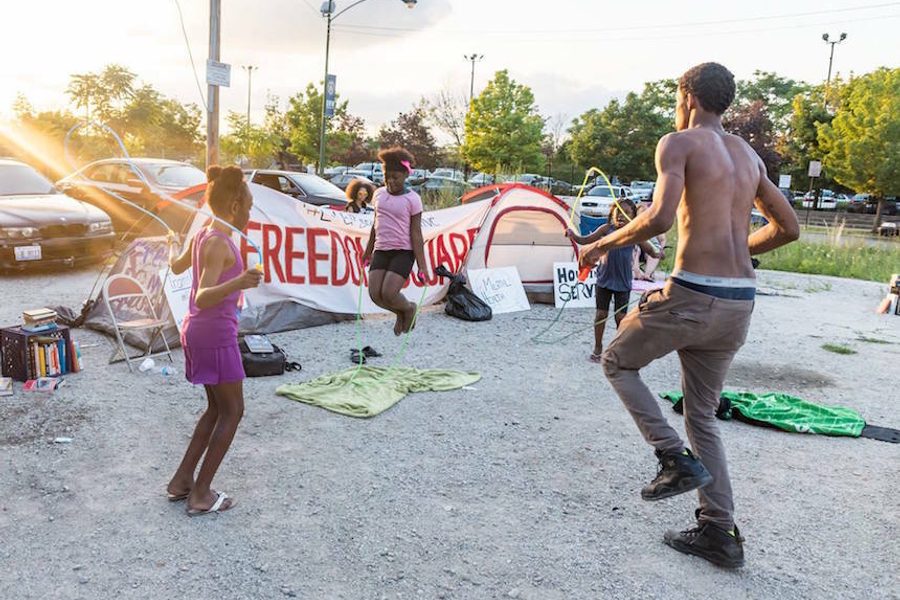The Occupation in Chicago That’s Building a Community Free from Racist Policing and Prisons
For over two weeks, young, Black activists have camped out to protest police oppression and imagine a more just world.
Kali Robinson

When Martin Luther King Jr. moved to Chicago’s North Lawndale neighborhood in 1966, he advocated for fair housing for Black communities, sparking fires of social change in the North. 50 years later, at an anniversary march commemorating King’s “Chicago Freedom Summer” campaign for housing, economic and racial justice, the West Side community showed it still burns with that passion.
After that July 20 demonstration, young, Black activists occupied an abandoned lot across from Homan Square, a police “black site” where more than 7,000 detainees were “disappeared” — over 80 percent of them Black — many of whom were tortured and denied legal representation. The encampment, dubbed “Freedom Square,” sits in sharp contrast to Homan Square: Free clothing, food, activities and books are provided to revitalize a community beaten down by the police force.
In this neighborhood police brutality is not some distant concept, says Bella Bahhs, a member of the #LetUsBreathe Collective, a youth-based organization created in response to police killings, and one of several groups organizing the occupation. According to Bahhs, community members approach activists nearly every day with tales of torture experienced in the Homan facility.
“[The police] are state militias designed to oppress Black people, poor people and marginalized people,” says Damon Williams, the 23-year-old co-founder of the #LetUsBreathe Collective.
The Freedom Square occupation is one of a series of similar demonstrations in the Movement for Black Lives, most recently an occupation outside of New York City Hall, which helped pressure Police Chief Bill Bratton into resigning Wednesday. On the other side of the country, activists in Los Angeles have camped outside City Hall for nearly a month to demand the firing of Police Chief Charlie Beck.
In Chicago, Williams and his fellow activists’ immediate goal is to force city council to rescind two recent so-called “Blue Lives Matter” ordinances, which would cap the statute of limitations on police misconduct cases at five years and extend the city’s current hate crime policies to protect police officers. But in the long-term, the goal of the action is to abolish the police system and put an end to the systemic mass incarceration afflicting North Lawndale.
Bahhs says North Lawndale’s poverty and intra-community violence are perpetuated by a system that militarizes the police rather than aiding the struggling community. In a neighborhood with a poverty rate more than twice that of Chicago as a whole and a per capita income less than half, people need improved resources if they want to actually live rather than just survive, Bahhs says.
In lieu of the police and prisons, the activists are pushing for a system that promotes restorative health solutions, education, mental health services, addiction treatment and other non-oppressive remedies to the issues facing the community. Their message has elicited support from North Lawndale and beyond, and the occupation is entirely sustained by what one volunteer called an “overwhelming” amount of donations.
These donations are not only used to feed and clothe the community as a whole, but also to help the many children who visit Freedom Square. Each day, the organizers conduct activities to educate the children about Black culture and responding peacefully when a negative situation threatens to turn violent, says Shavonna Brown, a 22-year-old activist and North Lawndale native. For Brown, the educational activities are especially vital for the community, which has experienced numerous school closures. Meanwhile, Chicago’s budget allocates nearly $4 million per day to police.
“I thought children were our first priority,” Brown says.
Although many North Lawndale residents support the ideas behind Freedom Square, many in the community have yet to mobilize. Even if they believe in the movement, Brown says, many residents are too afraid of the police to become activists themselves. So far, the encampment has had no major altercations with police, although Brown says they are often seen near the site keeping an eye on the activists.
But Brown pays them no mind. She wants a better neighborhood for her six younger siblings and her daughter, and says that despite the police presence, simply talking about change is not enough.
“You can’t talk about it in the house. I’m tired of talking about it,” she says. “I’m showing action. We’re giving [North Lawndale] the voice [they] always asked for.”





